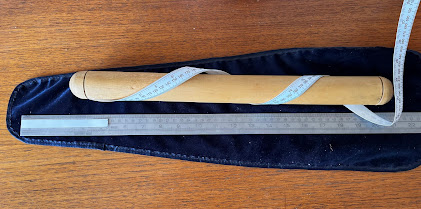On Helices
(Part 2 of Nuts & Bolts)
You will recall that some 15 years ago [1] I raised the question "Do modern metric nuts and bolts come loose spontaneously with greater facility than the nuts and bolts of my childhood". I was a little surprised to find no one taking up the enquiry, as it surely affect us all. (By the way, the handle is loose again on the cold tap in my new kitchen, thus defeating a handyman and two trained plumbers!). So, I decided to look further into the matter.
One useful step forward was identifying a company (BoltScience.com) with a testing jig that will rattle a couple of bolted plates till they loosen. They have not yet (so far as I can see) asked my questions, about metrication, tribology, and groove angle; but I may be able to cajole them into a colaboration. As a second step, I decided to make a deeper study of the helix, because its geometry is fundamental to the questions I am raising.
At the outset, let me clear up a possible confusion: a spiral staircase is a misnomer. A spiral would lie of the floor. We should talk rather of a helical staircase; c.f. Watson & Crick's double helix. Next, let us remind ourselves of some terms.
Let h = the (vertical) height of the helix up its long axis,
Let p = the pitch or lead up the long axis for each turn of the nut.
Let L = the length of the helix were it unwound and laid flat.
Let c = the circumference of the helix.
Let n = the number of turns; i.e. h/p.
I next wanted to see if I could calculate the area of the two surfaces that are juxtaposed when a nut is threaded on a bolt, the two surfaces between which the friction is generated that prevents the nut loosening; and for that I must calculate L, the length of the thread.
Not trusting my theoretical powers, I sought to measure L, to check theory. I found my wooden rolling pin (h=400mm), milled to a uniform diameter of 39.8mm which I determined by wrapping a paper strip round the cylinder and cutting it exactly to equal the circumference (c=125mm). I found that a dressmaker's measuring tape would lie adequately flat against the rolling pin, even when wound round like a ribbon on a May-pole.
Two extremes are easy. If the tape runs vertically up the pin, L simply equals h. And if the tape went round and round the pin without progressing up the pin at all, L could be infinitely long. I measured the length of tape needed to wind it round one full circle in the 400mm height of the rolling pin. And again with 2 full circles; etc.
No. of complete circles. Measured L (mm)
1 417
2 472
3 552
4 646
5 750
With string I could have explored further, but the tape was more convenient; and, lying flat against the rolling pin suggested the next step. With the tape making one complete cycle in the height of the pin, it was easy to see that the rather stiff tape made a precise angle (𝛉) against the vertical axis, which it maintained all the way round the pin. I could find L by applying Pythagoras's theorem to the little right-angled triangle: base = 𝛿c; height = 𝛿h; hypotenuse = 𝛿L.; and assume that the relations held all the way up. Furthermore, the angle off the axis (𝛉) can be calculated by applying trigonometric functions. For a single circle of the rolling pin, the cos of the angle (𝛉) of the thread to the axis is 'adjacent/hypotenuse' = 400/417, so 𝛉 = 17º; for two circles of the pin the angle between thread and axis (𝛉) is 32º [cos(32º)=400/472]. Likewise, the related small angle (90º - 𝛉) is arctan (pitch/circumference).
For each circle of the pin:
L2 = c2 + p2
But n (the number of turns) = h/p so, for a multi-turn helix we can predict:
L = h/p x √(c2 + p2)
I add these predictions to my table.
No. of circles. Measured L (mm) Calculated L (mm)
1 417 419
2 472 470
3 552 548
4 646 640
5 750 742
That is all very satisfying. And is a step towards calculating the area of the two mated surfaces between nut and bolt where friction prevents loosening.
REFERENCE
[1] https://occidentis.blogspot.com/2010/06/nuts-and-bolts.html

1 comment:
Comments are welcome, direct to cawstein@gmail.com
Post a Comment